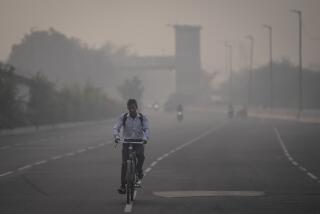The ‘City of Light’ Shadowed by Dirty Air; Traffic Blamed
- Share via
PARIS — Sunny weather means smog in Paris, where traffic fumes not only leave small children gasping for breath, but also are blamed for rising emergency room admissions for bronchial ailments and asthma.
The issue has gained increased attention with the entrance of the Green Party into the governing coalition, and from the release of well-publicized studies highlighting what many Parisians already sensed: The air they breathe is filthy and dangerous.
“We feel it more and more,” said Helene Carlier, whose baby has been hospitalized once for bronchitis and whose other two children frequently suffer from conjunctivitis.
On peak pollution days, Carlier tries to keep her children indoors. “It’s dangerous for them and for me too,” she said.
A survey in late April by the IFOP polling firm for Elle magazine said air pollution is by far the biggest ecological concern of urban women.
Watching traffic crawling down a boulevard next to the park where her kids play, Carlier said: “It’s a question of becoming aware of it. The French really didn’t have that before.”
The fumes coming from all those cars, buses and trucks blanket the City of Light with the same blight afflicting urban areas from Singapore to St. Petersburg to San Bernardino.
But Carlier, a lifelong Parisian, wouldn’t dream of abandoning her beloved city for a suburb.
“They need to limit the number of cars allowed into the city. It’s very irritating,” she said.
About 3 million cars enter Paris every day, and they are the major cause of the yellow haze that veils the city during major pollution alerts.
“The car is king,” said Dr. Manuel Maidenberg, a pediatrician who belongs to Respirer (Breathe), a group of doctors studying the effects of air pollution in Paris. “The number of cars must be reduced and urban transportation improved.”
A major study conducted by the Paris-area Regional Health Observatory found that emergency admissions to hospitals for asthmatic children jump 30% during maximum pollution alerts.
The report, based on research in 1991-95 and released earlier this year, said pollution is producing a “damaged generation” susceptible to chronic illnesses.
A study in 1996-97 by Maidenberg and about 100 other doctors found that 42% of 250,000 visits to Paris pediatricians were for respiratory problems.
Allergies, bronchitis, chronic coughing and conjunctivitis are among ailments on the rise.
Serious pollution alerts tend to occur when the weather is at its best, those stretches of glorious sunny days when there is little or no wind.
The cloudless weather means there is no rain or moisture to wash away or absorb auto emissions. Without wind, the toxic fumes stagnate in thick smog over Paris and other French cities.
In October, after a maximum smog alert, the national government for the first time imposed temporary restrictions in Paris that limited cars with odd and even license plate numbers to driving on alternate days.
Although the measure helped reduce pollution, it caused huge traffic jams and frustrated commuters who were crammed into subway and commuter trains.
Officials are studying other measures, such as more public transport, increasing the number of bicycle paths and further tax reductions for cars with cleaner engines.
“People are more and more aware of the problem,” Maidenberg said. “But they have very few choices.”
More to Read
Sign up for Essential California
The most important California stories and recommendations in your inbox every morning.
You may occasionally receive promotional content from the Los Angeles Times.













